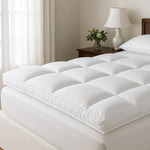You have no items in your shopping cart.
My old house is about to get updated! I'm going to move out for the biggest parts of the remodel, but what should I think about when it comes to sleep, during the project and after?
1. Noise. Remodeling is noisy. Plan for alternate sleeping arrangements if possible.
2. Dust and allergens. Construction work can stir up dust and allergens. Consider using an air purifier or three, and seal off areas that aren't being remodeled.
3. Comfort and safety. Ensure that your temporary sleeping arrangements are comfortable and safe. If you're moving to a different room or location in the house, make sure it's well equipped and secure.
4. Schedule disruptions. Nap during the day, probably not during a home remodel. Try to establish a new routine that accommodates the changes.
5. Ventilation and air quality. Proper ventilation is crucial to ensure that any fumes from paints or other materials don't affect your sleep quality.
6. Light control. Construction can affect natural light in your home. Ensure that your sleeping area can be darkened if you're sensitive to light.
7. Temperature control. Remodeling might impact your heating or cooling systems. Make sure your temporary sleeping space is well ventilated and maintains a comfortable temperature.
8. Safety hazards. Ensure that the construction area is safely contained and that there are no hazards that could affect your sleep, like exposed anils or unsafe flooring.
9. Mental and emotional well-being. Remodeling can be stressful! And that's going to affect your sleep. Try to manage stress through relaxation techniques or by setting time aside for yourself away from the construction area.
My old house is about to get updated! I'm going to move out for the biggest parts of the remodel, but what should I think about when it comes to sleep, during the project and after?
1. Noise. Remodeling is noisy. Plan for alternate sleeping arrangements if possible.
2. Dust and allergens. Construction work can stir up dust and allergens. Consider using an air purifier or three, and seal off areas that aren't being remodeled.
3. Comfort and safety. Ensure that your temporary sleeping arrangements are comfortable and safe. If you're moving to a different room or location in the house, make sure it's well equipped and secure.
4. Schedule disruptions. Nap during the day, probably not during a home remodel. Try to establish a new routine that accommodates the changes.
5. Ventilation and air quality. Proper ventilation is crucial to ensure that any fumes from paints or other materials don't affect your sleep quality.
6. Light control. Construction can affect natural light in your home. Ensure that your sleeping area can be darkened if you're sensitive to light.
7. Temperature control. Remodeling might impact your heating or cooling systems. Make sure your temporary sleeping space is well ventilated and maintains a comfortable temperature.
8. Safety hazards. Ensure that the construction area is safely contained and that there are no hazards that could affect your sleep, like exposed anils or unsafe flooring.
9. Mental and emotional well-being. Remodeling can be stressful! And that's going to affect your sleep. Try to manage stress through relaxation techniques or by setting time aside for yourself away from the construction area.








